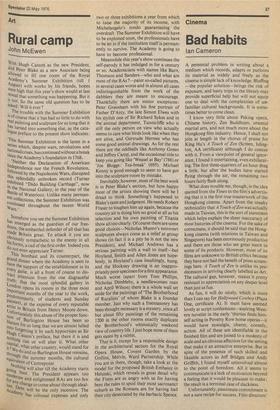Art
Rural camp
John McEwen With Hugh Casson as the new President, and Peter Blake as a new Associate being allowed to fill one room of the Royal Academy's Summer Exhibition (till 1 August
were with works by his friends, hopes high that this year's show would at last reveal that something was happening. But It is not. So the same old question has to be asked : Will it ever ?
, The trouble with the Summer Exhibition IS of course that it has had so little to do with real painting and sculpture for so long that it has turned into something else, as the catalque preface to the present show indicates: 'This Summer Exhibition is the latest in a series which, despite wars, revolutions and national crises, has continued without a break since the Academy's foundation in 1768. Neither the Declaration of American ,IndePendence nor the French Revolution, Tilowed by the Napoleonic Wars, disrupted this splendidly unbroken record (Turner exhibited "Dido Building Carthage", now In the National Gallery, in the year of the Battle of Waterloo). Unlike many permanent collections, the Summer Exhibition was continued throughout the recent World Wars,' Somehow you see the Summer Exhibition ,Ilas emerged as the guardian of our freeuoms, the embattled defender of all that has made Britain great. To attack it you are Obviously sympathetic to the enemy in all his forms, a cad of the first order. Indeed you do not even appreciate Turner. This bombast and its counterpart, the grand dinner where the Academy is seen to have the support of the establishment in its every guise, is all a front of course to distract attention from the one disgraceful truth: that the most splendid gallery in !London opens its rooms in the three most Important months of the year to the work, Predominantly, of students and Sunday Fs, at the expense of every reputable a. rtist in Britain from Henry Moore down. ofortunately this abuse of the proper function of Burlington House has been so ulatant for so long that we are almost lulled to forgetting it by such hypocrisies as Sir ugh Casson's preface, but there it is and nothing can or will alter it. What other apital , what other country, would stand for through we do and so Burlington House remains, the summer months, the cultural quivalent of Centrepoint.
oth■
—og will alter till the Academy starts !-"Ig bust. The President appears too fmooderate and enlightened RAs are too few is r anY change to come about through idealWill be the only incentive. The cademY has colossal expenses and only
two or three exhibitions a year from which to raise the majority of its income, with Michelangelo's tondo guaranteeing the overdraft. The Summer Exhibition will have to be exploited soon, the professionals have to be let in if the institution itself is permanently to survive. The Academy is going to have to become professional.
Meanwhile this year's show continues the self-parody it has indulged in for a century or so. Academicians with names like Burn, Thomson and Sanders—who and what are most of the RAs?—paint so-called pictures, in several cases worse and in almost all cases indistinguishable from the work of the dabblers they are meant to encourage. Thankfully there are minor exceptions: Peter Greenham with his fine portrait of Father D'Arcy, the late Simon Elwes with his stylish one of Sir Richard Sykes and in the animal department, Tunnicliffe who is still the only person on view who actually seems to care what birds look like when they are alive, and Gertrude Hermes who has some good animal drawings. As for the rest there are the oddballs like Anthony Green and Jeffrey Camp, and the occasional title to keep you going like 'Weasel at Bay' (788) or `Joe Bloggs: Tea-break' (695). Michael Kenny is good enough to seem to have got into the sculpture room by mistake.
Inevitably, however, most of the best work is in Peter Blake's section, but how happy most of the artists showing there will be I dread to think. Something's happened to Blake's taste and judgment. He needs Robert Fraser to toughen him up again, because the country air is doing him no good at all as his selection and his own painting of Titania show all too clearly. Of course there are some good choices—Nicholas Munro's extrovert sculptures always come as a relief at group shows (in fact it is a pity he is not the new President), and Michael Andrews has a serious painting with a wall to itself—but Hoyland, Smith and Allen Jones are hopelessly, in Hoyland's case insultingly, hung, and the Hockney drawing is an inappropriately poor specimen fora first appearance. Much worse (apart from Tom Phillips, Nicholas Dimbleby, a needlewoman man and April Wilson) there is a whole wall set aside for the paintings of 'The Brotherhood of Ruralists' of whom Blake is a founder member. Just why such a freemasonry has been thought necessary is a mystery, since all but about fifty paintings of the remaining 1200 in the other rooms exactly duplicate the Brotherhood's whimsically weekend view of country life. I just hope none of them gets eaten by a rabbit.
That is it, except for a responsible design in the architectural section for the Royal Opera House, Covent Garden by the Gollins, Melvin, Ward Partnership. While you are in there, though, take a look at the model for the proposed British Embassy in Helsinki, which reveals in great detail why the Finns are as angry with us for having bent the rules to spoil their most sacrosanct suburb as the Romans are for having had their city desecrated by the barbaric Spence.


































 Previous page
Previous page